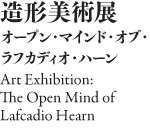Artists
Kinzo Nishimura / Mirei Shigemori
Japan
West -Setting Sun-
granite from Kyoto Kameoka and tsuga tree (Nishimura)
hanging scroll, sumi ink on Japanese paper (Shigemori)
西村金造
1938年
金造、京都市北白川に光造の三男として生まれる。
1961年
志度寺(香川県)の作庭を担当した重森三玲に呼ばれ、平等院型石灯籠を復元制作
この頃、イサム・ノグチ氏と出会い、以後十年の間、氏の石彫制作に従事する。
イサム・ノグチ氏デザイン、ユネスコ本部彫刻公園石工事
1962年
イサム・ノグチ氏デザイン、「黒い太陽」制作に従事
1964年
京都国際会議場、庭園石工事
1969年
兼六園(石川県)ことじ石灯籠火袋修復
1978年
大徳寺龍光院(京都府)の石灯籠の火袋・宝珠・笠を修復。同型石灯籠を制作
1979年
大徳寺本坊中庭、石灯籠制作
兼六園(石川県)ことじ石灯籠復元制作
大徳寺宿坊、五重層塔制作
ソビエト・キエフ市(現ロシア)、七重層塔制作
日本伝統工芸展(東京・西武百貨店)に石灯籠を出品し、激励賞受賞
1982年
日本伝統工芸士認定
1995年
桂離宮(京都府)庭園内、石灯籠・手水鉢・階段修復・復元(1998年まで)
1997年
長谷寺(奈良県)弘法大師像制作
修学院離宮(京都府)庭園内、石灯籠修復・復元(1999年まで)
平等院鳳凰堂(京都府)基壇石復元制作(2001年まで)
1998年
ウイーン・シェーンプルン宮殿(オーストリア)内日本庭、織部型石灯籠・手水鉢制作
1999年
京都御苑内大宮御所、石灯籠・手水鉢修復・復元
2000年
京都御所、石灯籠修復・復元
2002年
オランジェリ植物園(オランダ)日本庭園内、活込石灯籠制作
2003年
経済産業省より名工に選出される
2004年
京都府より石工芸師名工に選出
2005年
京都迎賓館庭園の石燈籠1点・手水鉢2店・その他石造工芸品2点制作他、数点制作。
2008年
日本国より瑞宝単光章受賞
Mirei Shigemori (1896-1975)
Shigemori was both a representative garden designer of Japan and a student of Japanese garden history. He was born in Okayama Prefecture. In his youth, he received lessons in traditional tea ceremony and Ikebana (flower arrangement) and studied Japanese painting at the Tokyo School of Fine Arts. In 1930, along with Sofu Teshigahara and others, he announced the “New Ikebana Declaration” proposing an innovative new style of Ikebana. He pursued his studies of Japanese Gardens publishing the “Illustrated Book on the History of the Japanese Garden” in 1939 and established a foundation for the study of garden history. After the war, he founded an avant-garde ikebana study group called “Byakutosha” and devoted himself to his studies, inviting Yukio Nakagawa and others to his home. Isamu Noguchi was also influenced by this design philosophy. Gardens designed by Mirei are characterized by the dynamic layout of their Japanese rock gardens, and a modern style of moss arrangement. His representative work includes the gardens of Hojo and Komyo-in at Tofuku-ji Temple, the garden of Zuiho-in at Daitoku-ji Temple and the garden at Matsuo Taisha Shrine.







